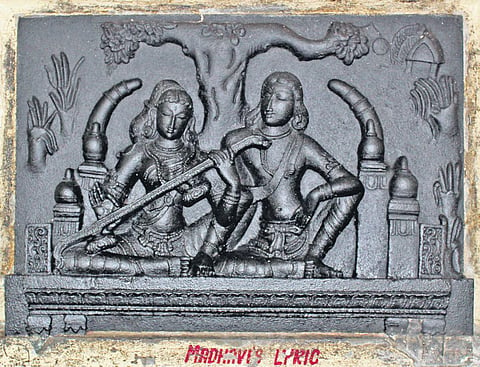

CHENNAI: A treasured work like Silappathikaram needs no introduction. The Sangam epic by poet Ilango Adigal is one among the five perum kappiyam or mahakavya in Tamil literature. While it’s often the compelling storyline around the characters Kovalan, Kannagi and Madhavi that’s celebrated, an hour-long virtual discussion by historian Meenakshi Devaraj and textile researcher Sreemathy Mohan, on Saturday, turned the spotlight on the attire and ornaments that find prominence in this piece of literature.
Delving into the topic, Meenakshi, who has been reading up extensively on Tamil inscriptions, local history and kolams, narrated, “The beauty of Silappathikaram lies in how the plot starts from the Chola land, travels through Pandya land and ends in Chera land. It offers so much information right from the food the people of these lands consumed, the culture that was prevalent, the gods they worshipped and more. One among them is the dressing pattern they embraced.”
Drapes of glory
The clothing and weaving industries were flourishing in the land of Tamils where garments used to be traded between the Pandyas and the Romans. “Some of the words used to describe clothes in the epic were udai, udukai, aadai and izhai. Adiyarku Nallar, one of the earliest commentators of Silappathikaram, mentions 36 types of clothing used in that period. Saadhar was a blue silk worn by Madhavi around the hip. Kalingam was a superior type of clothing. Though there were no direct references for sari, it was often called madi. All the clothing for women had floral or other patterns on them,” she elaborated.
Some garments worn by men were meipai to cover the upper body and kanjugam, a long top. Drawing references from the rich variety of fabrics and motifs enjoyed by the people of that period, Meenakshi throws light on the workmanship of the tailoring and weaving community behind them. “There was a tailor settlement in Madurai called Thunnar. Even in Poompuhar, the ancient flourishing port, some weavers wove and sold clothes in cotton, silk and animal fur. They were called karugar or pattu saliyar who could even do embroidery,” she notes.
There is evidence of perfumery used by merchants to protect clothes while trading, points out Meenakshi. Scents like vetiver and sandal pouches were kept between clothes for fragrance. “New clothes were considered auspicious even back then and were called kodi thuni. Venpattu or white silk was worn during celebrations and special occasions,” she shared.
All that glitters
If that wasn’t enough evidence to suggest the extravagant lives led by people, Meenakshi dives into the jewellery that played a significant part in their lifestyle. Besides the silambu or anklet that’s often glorified in the epic, there were precious gems, diamonds and golds. “There were four types of diamonds in white, red, black and green. There was an abundance of pearls, some in red, white and the big korkai pearl. There were also 8-12 pointers to identify defects in these gems that were documented. We only know of 24-carat gold now. Back then, there were four types depending on quality often denoted by flags,” she revealed.
What fascinated Meenakshi the most was the meticulous description of the exhaustive range of ornaments worn by Kannagi and Madhavi. “While there are mentions of two types of jewellery for men — kazhal worn in the leg and aaram on the chest — there’s more for women. In a scene where Madhavi dresses up to impress Kovalan, she takes bath in herbal water that is soaked with 10 types of thuvar, five types of virai and 32 types of oomaalligai (incense and aromas). She applies milk for her hair and ghee as a conditioner. There is also evidence that she performed 11 types of koothu (dance) and wore appropriate costumes for each,” shared Meenakshi.
The women, particularly Madhavi, were decked up from head to toe. “Madhavi wore kalani (metti) and peeli on her toes. She wore kuruncheri on her thigh, virisigai (with 32 stands of pearls) around her hip, gandhacharam on her shoulder and sarvadi around her neck. All her neck chains were tied at the back with a hook. From the hook, a chain made with pure pearls used to hang at the back. Her earring, called kudhumbai, had diamonds. There were rings on her fingers and bangles in her hands. There were accessories to adorn the hair too. While Kannagi enjoyed a similar luxury, she wore a mangalaani (mangalsutra). A daughter of a merchant, even during their dark phases, Kannagi continued to wear her anklet always,” she explained.
In one of the popular scenes where Kannagi proved her husband Kovalan’s innocence at the court, she throws the anklet in anger and the precious gems scatter on the floor. “Even in the temple built by the Chera king Senguttuvan for Kannagi, jewellery was given utmost importance. Cut to today, while the jewellery has been identified and been in the news, much of the attire has been lost with time. I hope somebody revives them and documents them,” says Meenakshi, who plans to have talks on the ornaments and attire in Manimegalai and Seevagasinthamani. “There’s so much to explore in these epics. We need to present it in such a way to the younger generation that draws their interest towards reading and preserving it,” she shared, as the session concluded.